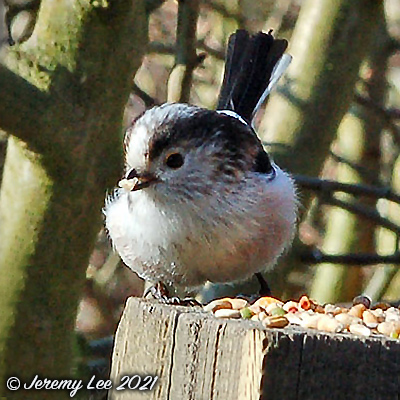
 |
|
Scientific Classifications explained » Amphibians » Ants » Aphids » Bees » Beetles » Birds » Bugs » Butterflies » Caterpillars » Damselflies » Dragonflies » Earwigs » Flies » Frog/Leafhoppers » Fungi » Galls » Grasshoppers » Harvestmen » Hoverflies » Lacewings » Ladybirds » Leaf Mines » Lichens » Mammals » Millipedes » Mosses » Moths » Sawflies » Slugs » Snails » Spiders » Trees » Wasps » Wild Flowers » Woodlice |
UK Nature > Birds > Aegithalos caudatus

Scientific Name: Aegithalos caudatus Common Name: Long-tailed Tit Aegithalos caudatus, more commonly known as the Long-tailed Tit, is easily recognisable with its distinctive colouring - the shoulders and underparts are pinkish, the head has a white crown with black marks above the eyes and into the nape. They have red eye rings and a very small black bill. The tail is bigger than its body, and is very noticeable during its undulating flight. Gregarious and noisy residents, long-tailed tits are most usually noticed in small, excitable flocks of about 20 birds. Like most tits, they rove the woods and hedgerows, but are also seen on heaths and commons with suitable bushes. They are to be found right across the UK except for the far north and west of Scotland. They can be seen in woodland, farmland hedgerows, scrubland, parkland and gardens. In winter they form flocks with other tit species. They can be seen all year round, feeding mainly on insects; however they have been known to eat seeds in autumn and winter (see photograph above). |
|

https://www.uknature.co.uk is a website dedicated to showing the immense diversity of UK nature and wildlife. Our vast range of habitats, from lowland arable to snow covered mountains, from storm-ravaged coastlines to peaceful inland freshwater lakes and rivers, from dry, sandy heaths to deciduous and coniferous forests, all these habitats contribute to the abundance of UK nature. We have wild birds in huge numbers either residing or visiting our shores (597 recorded species as at July 2013) and we must also not forget the humble back garden with its grass lawns, flower beds filled with nectar rich flowers, shrubs and trees, all designed to attract huge numbers of insects such as bees, moths, butterflies and hoverflies; and finally the small ponds which provide safe havens for frogs, toads, newts and even slow worms and grass snakes. www.uknature.co.uk is the showcase for my personal passion, photographing uknature in all its glory. I sincerely hope you all enjoy the fruits of my labours. This site and all images contained therein is © Jeremy Lee 2004 - 2021. All Rights Reserved. Site design by Jeremy Lee. Site development & IT Support by Stuart Lee. |